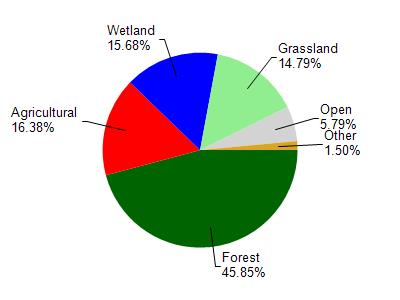Barron, Polk
No
No
Yes
Fish and Aquatic Life
Overview
Staples Lake is a soft water drainage lake on the Polk County border. It has an inlet, Staples Creek, and an outlet that is the headwaters of the Apple River. The fish population consists of northern pike, walleyes, largemouth bass, bluegills, black crappies, pumpkinseeds, bullheads and perch. The shoreline vegetation is mainly upland hardwood with some scattered white pine and open farmland. Sixty-five acres of wetland near the lake offer habitat for muskrats, nesting puddle ducks, mergansers and coot. A few Canada geese use the lake during migratory seasons. A public access is located on the northwest side of the lake and is the only public frontage. Private development consists of two resorts and boat rental places and 12 cottages and homes.
Source: 1964, Surface Water Resources of Barron County Staples Lake T35N, R14W, Section 19 Surface Acres = 336.8, S.D.F. = 1.31, Maximum Depth = 15 feet
Date 1964
Author Aquatic Biologist
Historical Description
The community around this 305 acre lake formed a lake district in 1975 and the feasibility study was completed three years later. An extensive implementation project followed in 1980 and involved non point source control work in the watershed. Some Department of Natural Resources monitoring was conducted in the subsequent years but none since the mid 1980's. This lake should receive high priority for water quality monitoring.
Date 1992
Author Aquatic Biologist
Impaired Waters
The 2018 assessments of Staples Lake (WBIC 2631200) showed impairment by phosphorus; total phosphorus sample data overwhelmingly exceeded the 2018 WisCALM listing thresholds for the Recreation use and Fish and Aquatic Life use. Chlorophyll-a sample data exceeded the REC and FAL thresholds. Based on the most updated information, this water was proposed for the impaired waters list.
Date 2017
Author Ashley Beranek
Condition
Wisconsin has over 84,000 miles of streams, 15,000 lakes and milllions of acres of wetlands. Assessing the condition of this vast amount of water is challenging. The state's water monitoring program uses a media-based, cross-program approach to analyze water condition. An updated monitoring strategy (2015-2020) is now available. Compliance with Clean Water Act fishable, swimmable standards are located in the Executive Summary of Water Condition in 2018. See also the 'monitoring and projects' tab.
Reports
Management Goals
Wisconsin's Water Quality Standards provide qualitative and quantitative goals for waters that are protective of Fishable, Swimmable conditions [Learn more]. Waters that do not meet water quality standards are considered impaired and restoration actions are planned and carried out until the water is once again fishable and swimmable
Management goals can include creation or implementation of a Total Maximum Daily Load analysis, a Nine Key Element Plan, or other restoration work, education and outreach and more. If specific recommendations exist for this water, they will be displayed below online.
Monitoring
Monitoring the condition of a river, stream, or lake includes gathering physical, chemical, biological, and habitat data. Comprehensive studies often gather all these parameters in great detail, while lighter assessment events will involve sampling physical, chemical and biological data such as macroinvertebrates. Aquatic macroinvertebrates and fish communities integrate watershed or catchment condition, providing great insight into overall ecosystem health. Chemical and habitat parameters tell researchers more about human induced problems including contaminated runoff, point source dischargers, or habitat issues that foster or limit the potential of aquatic communities to thrive in a given area. Wisconsin's Water Monitoring Strategy was recenty updated.
Grants and Management Projects
Monitoring Projects
| WBIC | Official Waterbody Name | Station ID | Station Name | Earliest Fieldwork Date | Latest Fieldwork Date | View Station | View Data |
|---|
| 2631200 | Staples Lake | 10000647 | Staples Lake | 7/3/1977 | 4/1/2025 | Map | Data |
| 2631200 | Staples Lake | 10019705 | Staples Lake -- Access | 8/15/2024 | 8/15/2024 | Map | Data |
| 2631200 | Staples Lake | 10018071 | Staples Lake -- Access | 8/15/2007 | 8/15/2024 | Map | Data |
| 2631200 | Staples Lake | 033193 | Staples Lake - Deep Hole | 10/3/2001 | 9/28/2025 | Map | Data |
|

Watershed Characteristics
Staples Lake is located in the Upper Apple River watershed which is 195.43 mi². Land use in the watershed is primarily forest (45.90%), agricultural (16.40%) and a mix of wetland (15.70%) and other uses (22.10%). This watershed has 138.62 stream miles, 7,663.43 lake acres and 16,247.07 wetland acres.
Nonpoint Source Characteristics
This watershed is ranked Medium for runoff impacts on streams, High for runoff impacts on lakes and Low for runoff impacts on groundwater and therefore has an overall rank of Low. This value can be used in ranking the watershed or individual waterbodies for grant funding under state and county programs.This water is ranked High Lake for individual Lakes based on runoff problems and the likelihood of success from project implementation.